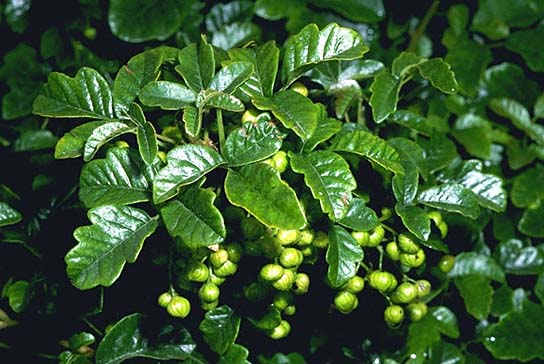|
|
|

Poison Oak
(Toxicodendron (Rhus) diversilobum)
Description: An erect or spreading shrub or a climbing vine with 3-parted leaves and brown or whitish berries.Height: shrub to 6 (2 m); as a climbing vine may ascend tree trunks to great heights.
Leaves: alternate, compound, 36 (7.515 cm) long, shiny dark green above, turning red in fall; leaflets 3, 14 (2.510 cm) long, more or less ovate or oblong, the edges variously blunt- or round-toothed or lobed (rarely untoothed); terminal leaflet has distinct petiole.
Bark: grayish.
Flowers: small, usually in panicles that droop from leaf axils; 5 petals, 5 sepals, and 5 stamens; AprilMay, appearing with the leaves.
Fruit: brown or whitish berry about 1/4 (6 mm) in diameter; falling shortly after ripening.
Habitat: Shady to open woods, streambanks, thickets in damp bottomlands.
Range: Washington to Baja California, east to Arizona.
Discussion: Western Poison Oak is not a true oak, but a close relative of Poison Ivy (Toxicodendron radicans). Poison Ivy also has 3-parted compound leaves, but the leaflets are not lobed and have more slender, pointed tips. Poison Ivy replaces Poison Oak east of the Pacific Coast region. Like Poison Ivy, Poison Oak secretes an oily juice to which many people are severely allergic. Merely touching any part of the plant is enough to cause painful dermatitis characterized by a blistery, oozing, extremely itchy rash. Coming into contact with the smoke of burned Poison Oak may cause severe eye and lung irritation. Nonetheless, livestock and deer commonly browse the plant without ill effect. Poison oak is so widespread and common in California that it almost qualifies as the state shrub. Anyone spending time in the lowlands and foothills of the state should learn to recognize the plant and avoid it at all costs. Some people initially show little response to Poison Oak only to become sensitive later. Washing exposed parts with a strong soap such as Fels Naptha shortly after contact has been known to prevent dermatitis. Over-the-counter cortisone creams provide some relief from itching in mild cases; where dermatitis is more severe, victims may want to see their physician.